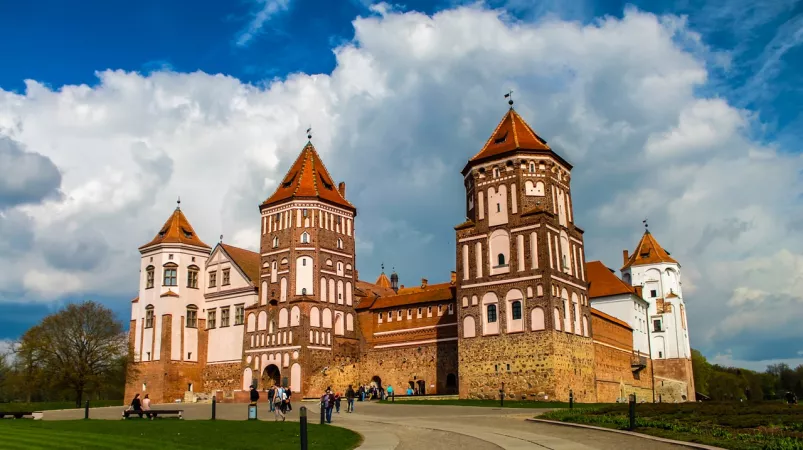
Belarus
Duration
3 to 5 Days
3 to 5 Days
Best time to visit
Jun-Aug
Jun-Aug
Theme
Heritage
Heritage
Belarus Travel Guide
Belarus, a landlocked country in Eastern Europe, is known for its rich history, diverse geography, and vibrant culture. With roots dating back to the medieval era, Belarus has been influenced by various empires and civilizations over the centuries. The country boasts stunning landscapes, including lush forests, picturesque lakes, and charming villages. Belarus is famous for its well-preserved medieval castles, orthodox churches, and Soviet-era architecture.Top Attractions in Belarus
1. Mir Castle Complex 2. Białowieża Forest 3. Nesvizh Castle 4. Minsk City 5. Khatyn MemorialBelarus is Famous for
Belarus is most famous for its well-preserved medieval castles and rich cultural heritage.Top Attractions in Belarus
- Mir Castle Complex - Białowieża Forest - Nesvizh Castle - Minsk City - Khatyn MemorialWhat's Great about Travelling to Belarus?
- Rich history and cultural heritage - Picturesque landscapes - Authentic local cuisine - Affordable travel destinationWhat's Not So Great about Travelling Belarus?
- Language barrier (limited English spoken) - Limited tourism infrastructure - Harsh wintersTravel Tips for Belarus
- Check visa requirements beforehand - Use public transportation in cities - Respect local customs and traditions - Be cautious of pickpockets in crowded areasImportant Belarus trip information
- Ideal Duration: A week to explore major attractions.
- Best Time to Visit: May to September for pleasant weather.
- Nearby Airports and Railway Stations: Minsk National Airport, Minsk Railway Station.
FAQ's on Belarus
Q1: What is the best time to visit Belarus?
The best time to visit Belarus is during the summer months from June to August when the weather is mild and the country is in full bloom. This is also the peak tourist season with many events and festivals taking place. However, if you prefer fewer crowds, consider visiting in the spring (April and May) or autumn (September and October) when the weather is still pleasant. Winter can be cold but offers a unique experience with winter sports and festive markets.
Q2: Do I need a visa to travel to Belarus?
Most tourists require a visa to visit Belarus. However, there are exceptions for certain countries, such as visa-free travel for up to 30 days for citizens of specific countries arriving through Minsk National Airport. It is advisable to check the latest visa requirements and regulations before planning your trip to Belarus.
Q3: What are the must-visit attractions in Belarus?
Belarus offers a mix of historical, cultural, and natural attractions. Some must-visit places include the Mir Castle Complex, Nesvizh Palace, Bialowieza Forest (UNESCO World Heritage site), the capital city of Minsk with its impressive architecture and museums, and the picturesque town of Vitebsk known for its artistic heritage. Nature lovers can explore the Braslav Lakes National Park or visit the charming villages of Dudutki and Khatyn.
Q4: Is Belarus a safe place to travel?
Belarus is generally considered safe for travelers. However, it is advisable to exercise caution in crowded areas and be vigilant, especially in larger cities. Avoid political demonstrations and follow local laws and regulations. As with any destination, it is recommended to keep your belongings secure and be aware of your surroundings.
Q5: What is the local currency in Belarus and can I use credit cards?
The official currency of Belarus is the Belarusian Ruble (BYN). While credit cards are widely accepted in major establishments in cities like Minsk, it is advisable to carry cash for smaller purchases and in rural areas. ATMs are also available in urban centers for convenient currency exchange.
Q6: What is the local cuisine like in Belarus?
Belarusian cuisine is hearty and traditional, featuring dishes like draniki (potato pancakes), machanka (pork stew), and kolduny (stuffed dumplings). Visitors can also try local specialties such as smetana (sour cream), kvass (fermented beverage), and various types of smoked meats. Vegetarians may find limited options, but most restaurants offer salads, soups, and dairy-based dishes. Be sure to sample the homemade bread and pastries, as well as Belarusian vodka and herbal teas.
Q7: What transportation options are available in Belarus?
Belarus has a well-connected transportation system with options including buses, trains, trams, and trolleybuses in cities like Minsk. Taxis are also available, and ride-sharing services are becoming more popular. Renting a car is a convenient way to explore the country, especially if you plan to visit rural areas or national parks. Additionally, domestic flights are available for travel between major cities.
Q8: Are there any cultural norms or etiquette I should be aware of when visiting Belarus?
When visiting Belarus, it is important to show respect for local customs and traditions. Greetings are formal with a handshake and maintaining eye contact. Belarusians are known for their hospitality, so accepting offers of food or drink is considered polite. Dress modestly when visiting religious sites and remove your shoes before entering someone's home. It is customary to bring a small gift when invited to someone's house. While Russian is widely spoken, learning a few basic phrases in Belarusian can be appreciated by the locals. Overall, being polite, punctual, and considerate will help you have a positive cultural experience in Belarus.
Q9: I am a travel agent. How can I buy travel leads of Belarus?
Register yourself as a travel agent at agents.tripclap.com and then you can buy travel leads to Belarus once your account is approved. For more details contact our support team at +91-8069186564 or support@tripclap.com
